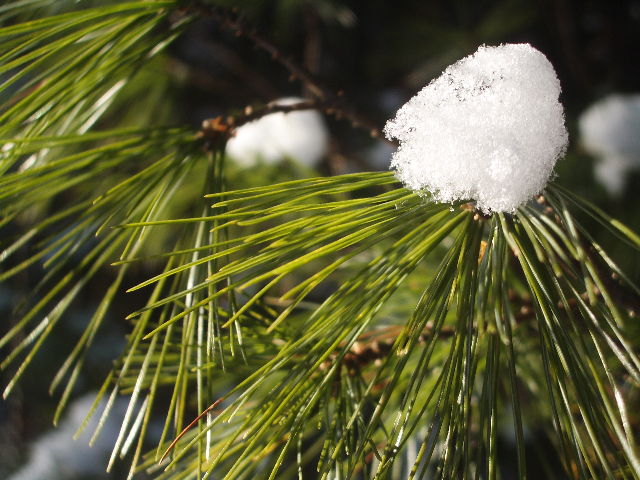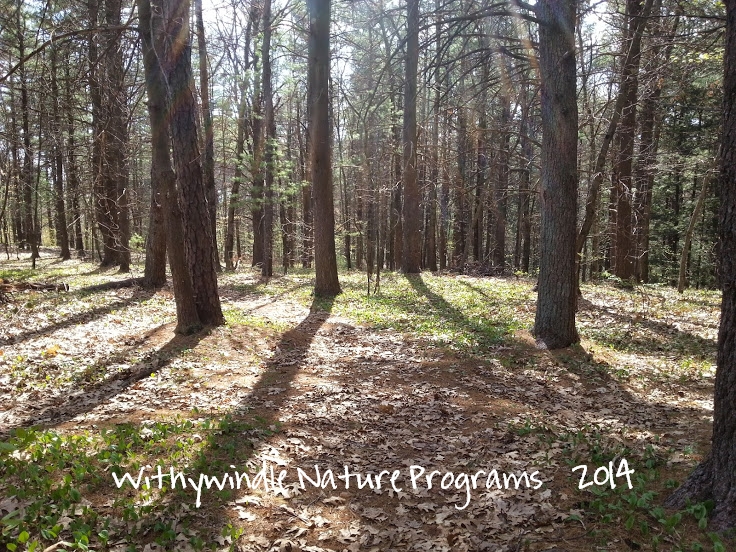I live in the kingdom of pine trees, nestled among the white pines of Bear Brook State park in New Hampshire. It grows well on the poor, sandy soil found here. Although it’s an ongoing battle for me to remedy the lack of soil fertility here on my property (not helped by the shade and acidifying roots of the pines), I enjoy having them as my neighbors. They are the first thing I see when I wake up and look out my window in the morning, and they offer me medicine and scenery all year long.
Natural History: White pine is our predominant pine and evergreen in Central/Southern New Hampshire, in part because it is well adapted to (and amplifies) our acidic soil. It has long horsetail-like needles that grow on the branches in bundles of five. Its species name “strobes” is an ancient name for an incense-bearing tree, most likely for the aromatic resin that exudes out of injuries to protect the tree. Straight white pines are important for lumber and exceptional pines were once marked as “King’s Pines” for British Navy floorboards. On younger trees, each whorl of branches signifies one year of growth. Turpentine, a paint thinner, solvent, and old-timer (toxic) remedy is made from pine. Yellow pine pollen can be found everywhere in spring. Rake up last year’s fallen pine needles for use as organic mulch in the garden—according to local organic and native plant landscaper Ayn Whytemare, pine needles are among our best and most economical mulch sources. They’re abundant, effective, less apt to harbor slugs or contain weed seeds compared to straw and hay. Contrary to popular opinion, pine needles to not significantly acidify the soil. Pine roots do. Pine branches make an attractive decoration during the winter months, bound together with wire as a wreath or spray.
Medicinal Activity of the Needles: Young bright green needles are a good source of vitamins C and A, and they make a tasty infused tea for camping trips and bonfires. The needle tea has value for lung congestion. The needles are slightly antiseptic but also quite astringent from the tannins. These tannins are also useful for diarrhea and any weepy membrane condition. The tea has a mild diuretic and expectorant action as well. Spring and summer new growth at the tips of the branches is the best for medicine since it has stronger resinous compounds and other constituents, has gone through fewer winters, and has more soluble constituents. However, for quick use, you can harvest the needle tips at any time. Opt for small branches with the newest, distal growth, and make a clean cut to minimize damage to the tree. Dry or fresh needles can be infused into a wintery-tasting tea. It’s easiest to harvest needles from stands of young trees, but you can also look for fresh blow-downs after a storm – these are especially useful for gathering resin.
To make a tea, infuse one handful of needles in a pint of hot water, covered, for 15-30 minutes, strain and drink. This tea is a bronchial dilator, vasodilating, expectorant, and warming. Inhale or drink to soften mild or early bronchitis. It can be used for mild lung congestion and tightness. Add a strong tea to the bath for sore joints, arthritis, and pain that comes on with barometric pressure and storms. The tea is diuretic and also contains some vitamin C. Or, warm the fresh boughs until soggy and place on sore joints. Gently simmer the needles to make a delicious honey that can be used somewhat like caught syrup.
To make an infused honey, which can be used as a cough syrup, combine 1/2 cup of chopped needles with 2 cups of honey. Bring to a gentle boil, stirring frequently. Once it comes to a boil, shut it off and let it cool. Repeat as many times as necessary to get the flavor you want, and strain into a mason jar during the last heating. This can be taken by the spoonful, added to tea, or combined with medicinal tinctures for colds, etc. (Do not give honey to babies under 12 months of age. Normally benign botulism spores naturally present in honey can develop into a dangerous botulism infection in babies’ underdeveloped digestive systems.)
Medicinal Activity of the Pitch & Essential Oil: Warmed pine resin can be placed on a splinter, boil, sore, or insect bite to help draw out the irritant. It increases circulation locally (which may cause a productive throbbing) and acts as an antiseptic. Soaked into a warm cloth, it can be placed on sore joints and muscles to relieve pain, or to the chest for pneumonia. A few drops of essential oil added to a bath or inhaled as a steam is similarly useful and convenient. Collect the resin from freshly broken twigs and limbs and store in a glass container that can be gently warmed once the resin has formed a thick, sticky, dry resin. This resin can also be placed on smoldering charcoal for incense. The fresh woodsy smoke is believed to clear negative energy from an area.
Similar species: Our other common pine is Red Pine (Pinus resinosa), which has more compact, decorative pinecones and needles bundled in pairs. It was once popular as a reforestation tree and so is abundant around Bear Brook State Park, though these are unfortunately being removed in 2013 due to a red pine scale infestation. The Pinus genus is vast and shares similar properties. Fortunately for us, White Pine is the favored medicinal species and the most abundant species.
Cautions: Although pine contains similar aromatics and healing properties as the other aromatic evergreens (balsam fir, hemlock tree), it may be more irritating to the kidneys and digestive system, making it less useful, says herbalist Michael Moore. Turn to the other trees if you are using the remedies regularly or have any kind of kidney inflammation.
Maria has been working with herbs for more than 15 years and been formally educated by some of the country’s top herbalists, including Rosemary Gladstar and Michael Moore. She’s certified as a clinical herbalist through the Southwest School of Botanical Medicine and currently runs Wintergreen Botanicals, an herbal clinic and education center nestled in the pine forest of Bear Brook State Park. Maria’s focuses on educating and empowering people with plant medicine: she sees clients, writes for various national and local publications, and teaches extensively throughout New Hampshire. Her website
www.wintergreenbotanicals.com is loaded with information, offering people a window into the world of herbalism.




Such great info here. Thanks!
Thanks Jen – Maria puts out such great and helpful articles; I’m looking forward to learning from her as this series goes on!
Superb blog you have here but I was wanting to know if you knew of any community forums
that cover the same topics talked about in this article?
I’d really like to be a part of group where I can get suggestions from other experienced individuals that share the same interest. If you have any suggestions, please let me know. Thank you!
I don’t know where you might find community forums – you could try Mother Earth News, or the Outdoor Blogger Network. Many blogs – this one included – that are on topic often have comments and discussions following posts, and most bloggers readily accept questions in the comments field. Thanks for visiting, and feel free to post questions here!